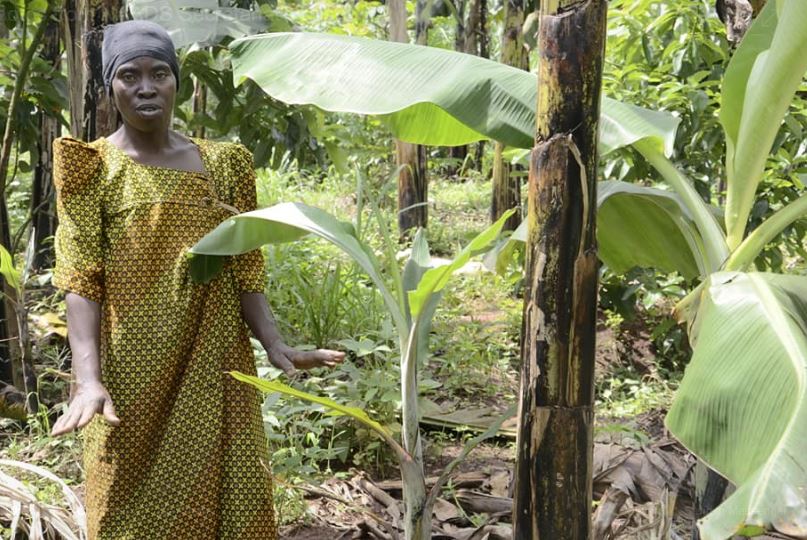By Isaac Tugume Nyabinghi
The National Agricultural Advisory Services (NAADS) is a government project that is helping farmers across the country fight poverty, by helping them engage in agricultural activities from which they earn millions of shillings.
According to a study conducted by experts from NAADS, Banana/plantain is one of the most important food crops in Uganda. About 75% of the farmers grow the crop on 1.3 million hectares.
Most of this production is for local consumption, although many farmers are these days embracing banana-growing for commercial purposes. In addition, banana-growing ensures a steady source of income to the farmer throughout the year, provides soil surface cover, reduces soil erosion on steep slopes, and is a principal source of mulch for maintaining and improving soil fertility. Banana also provides feeds for animals in livestock farming.
One of the rural farmers who has a success story to tell is
Sulaina Nakiwala, a housewife and resident of Nama Sub-county, in Mukono district, who managed to build her family a residential house using proceeds she got from her banana plantation.
Nakiwala says that “I started with 250 banana suckers from NAADS in 2016 and today I have expanded my plantation from 1 acre to 2 and a half acres.”
She added that “I not only support my husband to pay our children’s school fees but very soon we will be shifting from our old house to the new house we are constructing using funds earned from my banana plantation.”
Nakiwala, who sings praises for NAAD and the National Resistance Movement (NRM) for putting such a project in place, so as to help Ugandans fight poverty.
She urges all Ugandans both in rural and urban parts of the country to use the little land they have to grow bananas, because they have high demand and a ready market all year round.

Tips On Successful Banana Growing
These are tips from NAADS experts on how start up a banana plantation;
Selecting the Site
Bananas require deep, well-drained loam soil with high humus content, often of volcanic or alluvial origin. Very acidic soils are not suitable. Bananas require considerable amounts of nutrients to maintain high yields.
Preparing the Field
Bananas can be planted on fallowed land or newly established fields. In case of the latter, trees must be cut and some of the debris or obstacles from the forest burnt. If there are not much obstacles, planting can be done through the mulch. If the plantation is to be established on fallowed land, (3 to 5 years) the field should be simply slashed and left without burning. Burning is not usually recommended because useful organic matter is destroyed.
A pre- cultivation weed spray can reduce later weed control costs. A couple of weeks should be left between each cultivation to allow germination of weed seeds which are then killed by the following cultivation.
Spacing and Digging Holes
The recommended spacing is 3m between the planting rows and 3m within the row (3m x 3m) or wider depending on soil fertility.
Rows should be straight in flat fields to give plants 2the maximum amount of sunlight. 3 Rows should follow the contour lines on sloping land in order to decrease soil erosion.
Planting holes are prepared with minimum size of about 30cm x 30cm x 30cm, and most commonly 45cm x 45cm x 45cm, to as big and deep as 60cm x 60cm x 60cm.
Large and deep planting holes ensure that the roots of future plants exploit the greatest volume of soil and also plants withstand toppling by wind.
Source and Selection of Planting Material
The planting material must come from a healthy, disease and pest free plantation. Planting material (in-vitro plants) may be obtained from the Tissue Culture Laboratory at Kawanda. The most commonly used planting material are sword suckers, maiden suckers or corms. Sword suckers are preferred to other planting material. Suckers 1.8- 2.1 metres high and about 45cm in girth should be selected for planting. Small sword suckers may also be used. The sword suckers have the advantage of being less infected with nematodes and weevils than larger planting material.

Preparation of Planting Material
The bulb should be pared/peeled to remove all the roots and parts with damage (tunnels formed by weevil larvae or necrosis due to nematodes). Remove the last leaf sheaths as they may house weevil eggs or adult weevils.
The brown and black spots that may appear on the corms due to infestation by weevils and nematodes should be removed until only white tissue remains. If the infestation is severe, with many brown and black spots, the sucker should be destroyed. Sucker preparation should be carried out in the field where the planting material is collected or far away from the new field, to avoid contamination of the field with pests.
It is recommended to treat banana planting material with the water. A treatment for 20 minutes in water of a temperature between 53°C and 55°C kills the nematodes in the outer 1ayers of the planting material. It is advisable to plant the suckers within a week.
Planting Bananas
Bananas can be planted throughout the rainy season. However, they should grow vigorously and without stress during the 4 to 6 months after planting, and therefore should not be planted during the last months of the rainy season. 25mm of rainwater per week is the minimal 3 requirement for satisfactory growth. Well distributed annual rainfall of 2000 -250Ornm is satisfactory. The sucker is placed in the hole and its corm is covered, first with the top soil and then the 4 bottom soil.
In the planting hole, the sucker is tilted towards the edges of the hole. If the land is sloping, the sucker should be so oriented that the future ratoons emerge against the slope. This will delay the ratoon crop from growing out of the soil exposing the corm, a condition called high mat. If no hot-water treatment was used on the planting material you may apply insecticides or nematicides in the hole and on top of the soil after planting at recommended manufacturer’s rates. Farmers are advised to use Farm Yard Manure, which is put I in the planting holes several days prior to planting. Use of artificial fertilizers should be minimised as much as possible because of the high cost and inability of fanners to apply recommended quantities.

Intercropping
Before the banana canopy closes, a fair amount of inter row space remains unexploited during the first months. This space can be used for plants which have a short life cycle or which do not compete with bananas. The intercrop should be planted before (e.g. coffee or cocoa) or at the same time (e.g. legumes such as groundnuts, vegetables, maize) as bananas. Do not plant too close to the Banana plant. Advantages of Intercropping
Plantation Care And Maintenance
Weed control in the first year of life is very important. Keep the new plantation weed free to let the banana plants get well established. Once the plants get big enough for the leaves to 5 completely shade the ground, weeds become less of a problem and mulching can keep the weeds down. 3.1.1 Hoe and/or Hand Weeding Weeds can be hand-pulled or weeded with a hoe.
Hand or hoe weeding can either be carried out on its own or combined with chemical weed control. For example, ring or row weeding of the banana plants can be followed by a herbicide application on the remaining weeds.
Chemical Weed Control
Chemical weed control is less laborious, provides longer control and is faster than hand or hoe weeding. Chemical weed killers are applied using a knapsack sprayer. If a contact herbicide is used, precautions must be taken to avoid it to drift on to the bananas. Spraying should be done on a day with no or little wind.
Herbicides commonly used include Grammazone and Roundup. It is recommended that the operator follows the dosage instruction not smoke or eat during treatment, avoid contaminating human/animal water with the herbicide residues, or reusing herbicide containers for domestic purposes. Other cultural practices may restrict weed growth as well.
Mulching
Mulching has a number of roles: Restricts weed growth Protects the soil against heavy rainfall and intensive sunshine. Prevents erosion in plantations on steep slopes Provides organic matter. Stimulates root development Improves soil drainage. Decreases soil temperature Increases soil porosity and biological life.
It is therefore highly desirable for a fanner to mulch as often as possible on his plantation. Due to the difficulty of obtaining mulch, the cost of harvesting and transporting it in terms of labour, it is imperative to:
Use the mulch obtained from cleaning the bush when setting up a plantation. Use vegetable obtained from the plantation themselves; leaves, trash, pseudostem, stalks.
Use organic matter available near the plantation e.g. poultry , pig and cow manures. The mulching plants which are easier to grow and produce a substantial amount of vegetable matter are: Pennisetum purpureum (Elephant grass), Tripsacum laxurn (Guatemala grass) and Panicum maximum (Guinea grass). However, mulching is known to increase pest attack and toppling. Mulching therefore should be done off the mat.
Mulching should also be done when the crop has established in order to encourage a deeper rooting system. Negative geotropism of the roots starts when a thick mulch is introduced early in the plantation, hence the phenomenon of high mats.
Pruning/Desuckering
Pruning or desuckering is carried out to ensure that the number of bunch bearing plants is maintained at a level which stops competition (for water, light, nutrients) and sustains substantial yield?
Farmers are advised to desucker the banana mat to 3 plants at various growth ages (mother, daughter and grand daughter) in order to get big bunches. A special desuckering spade or knife or panga is used. The sucker pseudostem is cut off near its corm and the sharp point of the knife or panga is twisted in the growing point, thus killing it.
During these operations care must be taken not to harm the daughter plants. Generally, up to 6 months old suckers must be removed, at flowering up to harvest time. 1 or 2 suckers must be maintained. Always choose suckers which are coming from well down on the corm because the banana plant has a tendency to grow out of the ground.
The suckers should be on the opposite side of the bunch of the mother plant. 3.4 Fertilization Extra nutrients can be applied in the form of either organic (mulch, manure or ash) or inorganic fertilizers.
Organic Fertilizers
At least 7 Crop residues should be returned to the farm to compensate for the continual loss of nutrients at harvest. Many farmers who have banana plantations near their homesteads use some organic inputs by coincidence, through the traditional residue disposal system. This maintains good stands of banana where banana production has declined.
Well rotten farm yard or compost manure may be placed in the planting holes or after planting usually in the rains. The manure is ploughed in to a depth of 30-40cm over the soil surface or placed in the furrows between the rows or along the rows.
Inorganic Fertilizers
The application of adequate fertilizers increases production improves the grade of the fruit and reduces crop duration to maturity appreciably. Bananas have a high demand for nitrogen and potash and therefore respond very well to nitrogen and potash application.
Phosphorus is vital but it is required in smaller quantities. Application of inorganic fertilizers at an early stage is critical since this stage will affect the later phases in development.
Therefore mineral nutrients must be available at the time of planting or at the initiation of the ratoons. Some phosphates and potash should be applied in the planting holes and thereafter twice yearly, while nitrogen should be applied regularly at shorter intervals.
The fertilizer requirements may vary from farm to farm and year to year. Before applying any type of fertilizer advice should be sought from soil scientists or agricultural staff.
Deleafing
Deleafing is carried out on a regular basis because of plantation hygiene and appearance. The dead hanging leaves cover young suckers and the old sheaths on the base of pseudo stem provide an ideal refuge for adult banana weevils. Always remove these leaves and sheaths and use them as mulch. Leave enough leaves to produce a good quality bunch, at least 9-12 leaves at flowering and 4 at harvest. Complete deleafing of the plant prior to harvesting is not recommended as this starts the ripening process.
Propping
Propping up of banana is done in order to prevent the plants with maturing bunches from falling down. The heavy weight of the banana bunch bends the bearing plant and can cause doubling (pseudo stem breaks), snap-off (corm breaks, leaving a part in the ground) or uprooting, also called toppling (the entire corm with roots comes out of the ground).
Plants are generally weak during the dry season, strong winds, and nematodes and weevils also increase the rate of loss. So they always need support from 1or 2 wooded props usually made of bamboo. A lateral branch usually with a natural fork can be used. Depending on the weight of the bunch the branch (es) can be placed underneath the bunch or along the pseudo stem.
Harvesting
The time taken from flowering to harvest vary with cultivars, climatic conditions and sometimes management practices. Generally bunches take 3-4 months to mature. The methods of harvesting will be determined by the purpose of the bunch, either for home consumption, sale or brewing. The pseudo stem and foliage of the harvested plant should be chopped and spread over the soil as a mulch for the ratoon crop. This practice eliminates the breeding sites for the banana weevils.
Pests And Their Control
The banana weevil, Cosmopolites sordidus and plant parasitic nematodes are the most destructive pests of bananas in Uganda. These pests may result in severe yield loss if uncontrolled.
Banana Weevil
Damage and Symptoms Weevil damage results from larvae feeding and tunnelling into banana corms and pseudo stems. The adult weevil lays its eggs near the corm and on hatching the larva attack the underground part, boring tunnels in it. As weevil larvae grow in size, they make large tunnels 15 cm in diameter and may extend to 60- 100 cm up the pseudo stem. The damage weakens the plant and interferes with uptake of nutrients and water.
Weevil infestation of young plants causes stunting, disruption and delay of fruiting and sometimes leads to plant death. Heavily infested plants produce small bunches and have reduced resistance to drought and strong winds, leading to snapping and toppling of large or mature flowered plants. The banana weevil 9 causes more damage to the cooking types than the beer cultivars.
Weevils damage may increase when plants of reduced vigour are attacked. Low vigour usually results from plants being grown in soils with low moisture and fertility levels, weeds or intercrop competition, lack of de suckering which encourages competition for nutrients between suckers of the same plant and attack of plant by other pests and diseases.
Weevil damage is most severe between altitudes 1000-1200 m.a.s.1 and decreases at higher altitudes; little or no weevil damage is recorded in places like Kabale (17660 m:a.s.l) and Kapchorwa (1830 m.a.s.l). Absence of banana weevil from higher elevations suggests that the weevil has a lower temperature threshold for larval development or adult survival.
Control Measures
Cultural Methods Cultural control based on manipulation of weevil habitat and oviposition site provides the first line of defense against the banana weevils. It is cheap and does not entail extra inputs. Various other cultural practices are used and they include:
Use of Clean Planting Material
This minimizes the spread of the weevils which are mainly carried to new sites with infected suckers. Clean suckers may be obtained from non-infested fields, by paring the corm to remove eggs and larvae or by use of tissue cultured plants.
Hot water treatment (52°C for 20 minutes) was advocated for but this practice may not be very effective for weevil control especially when there are larvae in the planting material.
Good Husbandry
This involves clean weeding, desuckering, pruning, manuring and mulching, which produce vigorous plants that are more tolerant to weevil damage.
Destruction of Post-Harvest
Residues Removal and splitting of harvested stems into small strips and spreading them out to dry quickly reduces hiding and breeding sites for the weevil. It also exposes weevil eggs and larvae to desiccation.
Use of Mixtures of Ash, Urine and Insecticidal Plants Traditionally farmers have used ash in banana fields for soil nutrient enhancement and weevil control. Farmers are now using mixtures prepared by adding various levels of ash, urine, tobacco, capsicum, phytolacca and other weed species. The method and rates of application vary from farmer to farmer. But the most common one is use of a 14 day fermented mixture at 1-2 cups (500 ml -1000 ml) per banana stool. While the practice is being recommended and encouraged, its field efficacy is still unclear and research is under way to validate the practice.







